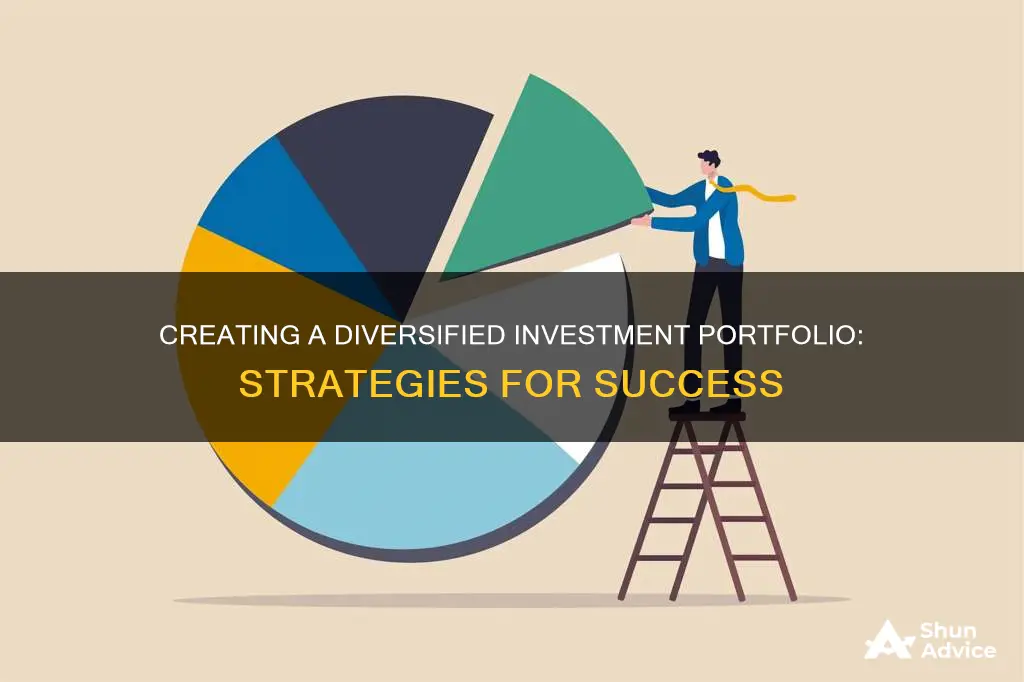
Creating a diversified investment portfolio is a crucial aspect of financial planning. The old adage, Don't put all your eggs in one basket, aptly describes the core principle of diversification, which involves spreading your investments across various assets, industries, and markets to reduce risk and enhance returns. Here's an introduction to the topic of diversified investment portfolios, providing an overview of the benefits and strategies for achieving effective diversification.
Diversification is a risk management strategy that aims to minimize potential losses by allocating investments across different areas. By not concentrating all your investments in a single basket, you lower the chances of significant setbacks if that particular area underperforms. Diversification also allows you to take advantage of growth opportunities in different sectors and reduce the impact of market volatility on your overall portfolio.
To create a diversified portfolio, you can employ several strategies. One approach is to invest in a variety of asset classes, such as stocks, bonds, cash, real estate, and alternative investments. Another strategy is to diversify within each asset class by investing in different industries, sectors, and geographic locations. Additionally, you can consider investing in index funds or exchange-traded funds (ETFs), which provide instant diversification by holding a basket of securities from various sectors. It's also essential to periodically rebalance your portfolio to maintain the desired level of diversification and risk.
By diversifying your investments, you increase the likelihood of long-term growth while reducing the potential for substantial losses. It's important to remember that diversification does not guarantee gains or eliminate risk entirely, but it helps smooth out the peaks and valleys of investing, making your financial journey less turbulent.
What You'll Learn

Invest in a variety of asset classes
Diversification is a key part of any investment strategy. The old adage "don't put all your eggs in one basket" is a good starting point for understanding the importance of diversification.
A diversified portfolio should include a mix of asset classes, with investments spread across a variety of different vehicles. This ensures that your portfolio is not overly exposed to any one particular market or industry, reducing the overall risk of your portfolio.
Equities (Stocks)
Equities, or stocks, are one of the most common types of asset class. When you buy shares of a company's stock, you are purchasing a small ownership stake in that company. The value of your shares will fluctuate based on the company's performance and broader economic conditions. Stocks tend to have higher yields than other asset classes but also come with greater risks.
Fixed Income (Bonds)
Fixed-income investments, such as bonds, are another important component of a diversified portfolio. These investments make fixed payments of income on a principal investment, with the principal returned at a specified future date. Bonds are typically issued by governments or corporations and are considered a relatively safe investment, especially those backed by stable governments.
Cash and Cash Equivalents
Cash and cash equivalents, such as money market accounts, Treasury bills, and certificates of deposit (CDs), are low-risk and low-yield investments. They provide liquidity and safety, making them valuable in volatile markets or economic downturns.
Real Estate
Real estate can be a valuable addition to a diversified portfolio. Investors can gain exposure to real estate by purchasing commercial or residential properties directly or by investing in real estate investment trusts (REITs), which are similar to mutual funds and trade on stock exchanges.
Commodities
Commodities refer to tangible resources such as metals, energy resources, agricultural goods, and even cryptocurrencies. Investors can gain exposure to commodities by purchasing physical assets or investing in futures, ETFs, or companies that produce these goods. Commodities can be a good hedge against inflation and can provide diversification benefits.
Alternative Investments
Alternative investments include hedge funds, private equity funds, venture capital, and other non-traditional investments. These tend to be more complex and restricted to accredited investors, but they can provide diversification benefits and the potential for higher returns.
Savings and Investments: A Comprehensive Guide
You may want to see also

Invest in different industries
Diversification is a crucial aspect of investment, often summarised as "don't put all your eggs in one basket". The basic idea is to spread your investments across different industries, companies, asset classes, and geographical locations. This approach helps to lower the overall risk of your investment portfolio, as the poor performance of one investment may be offset by the better performance of another.
- Invest in a variety of sectors: While it's important to have a diversified stock portfolio, remember that diversification within a single sector is not enough. For example, investors who owned a variety of tech stocks in the late 1990s were still heavily exposed to that sector. Ensure you have investments in tech, energy, healthcare, and other industries.
- Couple investments that counterbalance each other: For instance, during the pandemic, digital streaming platforms benefited from more shutdowns, while airlines benefited from fewer shutdowns. Investing in both these industries can minimise your overall portfolio risk.
- Diversify outside your home country: Holding investments in different countries can provide a cushion against economic downturns in your own country. For example, if the US economy is struggling, Japanese stocks may be less affected.
- Consider the impact of different monetary policies: Different countries have different monetary policies, which can provide varying opportunities and risk levels. For instance, a change in US corporate tax rates could negatively impact all US-based companies.
- Invest in different types of companies: Diversify your portfolio by investing in both large-cap and small-cap companies. Large-cap stocks tend to be safer, while small-cap stocks have more room to grow.
- Consider the growth stage of companies: Growth stocks are expected to experience profit or revenue growth above the industry average, but they are riskier. Value stocks, on the other hand, are more established companies that may have already realised most of their potential but carry less risk.
- Look at different market capitalisations: Consider the vast operational differences between companies of varying sizes. For example, Apple and Newell Brands Inc. are both in the S&P 500, but they differ significantly in brand recognition, growth potential, and approach to raising capital.
By investing in different industries, you can reduce the impact of sector-specific risks and smooth out the inevitable bumps in the road. Remember, diversification is about accepting uncertainty and taking steps to protect yourself from it.
National Saving Certificates: Smart Investment Strategies
You may want to see also

Understand the risks
Diversification is a crucial aspect of investment, but it's important to understand the associated risks. While it helps reduce overall risk, it does not guarantee against losses. Diversification aims to protect against significant losses by ensuring your portfolio isn't dependent on a single stock or industry. However, it's important to recognise the different types of risk.
Systematic or Market Risk
This type of risk is inherent to the market and cannot be mitigated through diversification. It is associated with factors like inflation rates, exchange rates, political instability, and interest rates, affecting all companies and industries.
Unsystematic or Diversifiable Risk
This risk is specific to a company, industry, market, economy, or country. It includes business risk, financial risk, operational risk, and regulatory risk. Diversification helps reduce unsystematic risk by ensuring your portfolio isn't overly exposed to these specific risks.
When diversifying, it's crucial to understand that different assets and investments carry distinct risks. For instance, equity markets may perform well despite interest rate hikes, but these hikes can negatively impact bond prices. Therefore, investors often split their portfolios across different asset classes to protect against widespread financial risk.
Additionally, it's important to consider the following risks and how they relate to your investment strategy:
- Company-specific risk: This includes risks associated with a company's leadership, legislation, acts of nature, or consumer preferences.
- Industry-specific risk: For example, investing solely in the technology sector during an economic slowdown may be risky if tech spending takes a hit.
- Country-specific risk: Different countries have different monetary policies and are exposed to varying levels of political, geopolitical, and international risks.
- Time frame risk: Longer-term investments often carry more risk but may offer higher returns to compensate.
While diversification is a valuable tool for managing risk, it's important to remember that it may also lower returns. By diversifying, you may miss out on the potentially higher returns of a concentrated investment strategy. Diversification aims for higher risk-adjusted returns rather than the highest absolute returns. Therefore, it's essential to find a balance between diversification and maximising returns, considering your risk tolerance and investment goals.
Solow Model: Investment Savings Strategy for Long-Term Growth
You may want to see also

Diversify your portfolio over time
Diversifying your portfolio over time is a key part of any investment plan. It is important to remember that investing is an art form, not a knee-jerk reaction, and that diversification is not a one-time task. Here are some tips to help you diversify your portfolio over time:
- Don't put all your eggs in one basket: This is the central idea behind diversification. By investing in a variety of assets and industries, you reduce the risk of losing all your money if one investment or industry performs poorly.
- Spread the wealth: Don't put all your money in one stock, one sector, or one type of investment. Consider investing in a range of companies you know, trust, and use in your daily life. You can also invest in commodities, exchange-traded funds (ETFs), and real estate investment trusts (REITs).
- Consider index or bond funds: Index funds, such as the S&P 500, are a great way to instantly diversify your portfolio at a low cost. Bond funds can also help to reduce the overall risk and volatility of your portfolio.
- Keep building your portfolio: Add to your investments regularly. If you have a large sum to invest, consider using dollar-cost averaging to smooth out the peaks and valleys of market volatility.
- Know when to get out: Buying and holding are sound strategies, but it's important to stay informed about your investments and the overall market conditions. This will help you know when to cut your losses and move on.
- Keep an eye on commissions: Understand what you are paying for when investing. Some firms charge monthly or transactional fees, which can chip away at your bottom line.
- Rebalance your portfolio: Over time, the size of the holdings in your portfolio will change as some investments perform better than others. To maintain a diversified portfolio, you should occasionally rebalance your portfolio to ensure that no single investment or industry dominates.
- Think global: Don't just focus on investment options in your own country. There are attractive opportunities in international markets, especially in emerging markets or countries with faster long-term growth rates than your own.
- Don't over-diversify: While diversification is important, it can be taken too far. Holding too many investments can make your portfolio unmanageable, and some investments may not add any diversification benefits. Focus on holding a manageable number of uncorrelated assets.
Savings or Investments: The Best Way to Utilize Your 100K
You may want to see also

Consider international markets
When creating a diversified investment portfolio, it is important to consider international markets. Here are some reasons why:
Reduced Risk and Smoother Returns
Including international stocks and assets in your portfolio can help reduce your overall investment risk. If the US stock market underperforms, gains in your international holdings can offset those losses and smooth out your overall returns. For example, if your domestic portfolio loses value, your international portfolio might advance, leaving you with a net gain. This strategy is particularly effective if you hold a selection of stocks from both developed and emerging markets.
Diversified Currency Exposure
When investing in international markets, you effectively buy the currencies in which the stocks are quoted. For instance, if you buy a stock listed on the London Stock Exchange, its value will rise and fall with the British pound. If the US dollar falls, your international portfolio can help neutralize currency fluctuations and provide a hedge against currency risk.
Access to Faster-Growing Economies
Some countries' economies are growing at a faster rate than the US, and their companies may benefit from this growth. For example, China and India have experienced rapid economic growth, and their stocks may offer attractive investment opportunities. By investing in international markets, you can gain exposure to these emerging markets and potentially higher returns.
Market Cycle Timing
An international portfolio allows you to take advantage of different nations' market cycles. You can invest in developing regions, such as Latin America and Asia, that are expected to benefit from capital inflow and increased demand for commodities. This strategy can help you diversify your investments and potentially generate higher returns.
Political and Economic Risk
However, investing in international markets also carries risks. Many developing countries may not have the same level of political and economic stability as the US, increasing the risk of significant losses due to political or economic events. For example, a political coup in a developing country could result in a sharp decline in its stock market.
Increased Transaction Costs
Additionally, investing in international stocks typically involves higher commission and brokerage charges, reducing your overall returns. You may also need to pay taxes, stamp duties, levies, and exchange fees, further diluting your gains. To mitigate these costs, consider gaining exposure to international markets through exchange-traded funds (ETFs) or mutual funds.
In conclusion, considering international markets as part of your diversified investment portfolio can provide numerous benefits, including reduced risk, currency diversification, and access to faster-growing economies. However, it is essential to be aware of the potential risks and costs associated with international investing.
Chris Gardner's Life Savings Investment: A Fateful Decision
You may want to see also
Frequently asked questions
Diversification is a risk management strategy that involves investing in a variety of assets and industries to reduce overall risk and maximise returns. By diversifying your portfolio, you can smooth out the peaks and valleys of investing, making it more likely that you'll stick to your investment plan.
The traditional approach to diversification is to have a mix of stocks and bonds in your portfolio. However, you can also invest in other assets such as cash, commodities, real estate, and alternative investments. When investing in stocks, aim to hold a mix of tech stocks, energy stocks, healthcare stocks, etc. from different industries and with varying market capitalisations.
A common rule of thumb is to subtract your age from 100 to determine the percentage of stocks in your portfolio. For example, a 30-year-old could have 70% stocks and 30% bonds. As you get older, reduce your risk exposure by increasing the percentage of bonds in your portfolio.
Alternative investments include hedge funds, private equity, real estate, debt investing, commodities, collectibles, and structured products. These investments operate in the private market and are largely unregulated, offering a low correlation with traditional assets.







